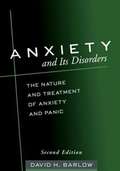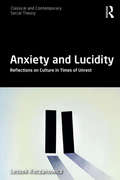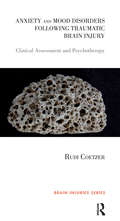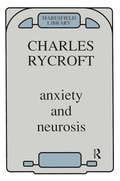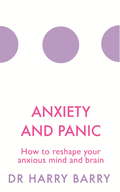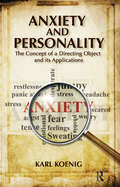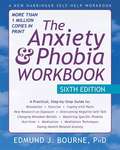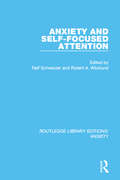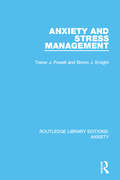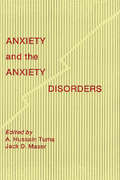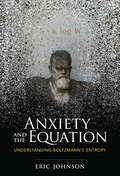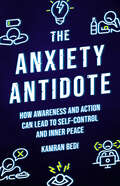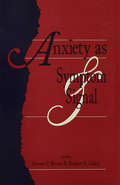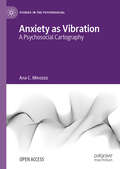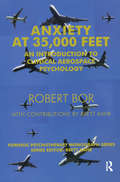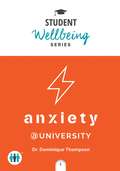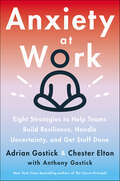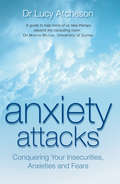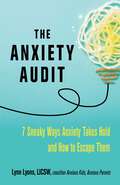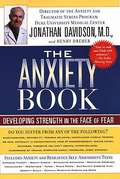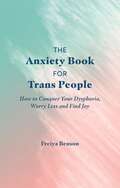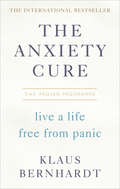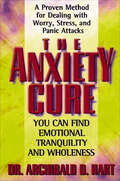- Table View
- List View
Anxiety and Its Disorders, Second Edition
by David H. BarlowThis landmark work is indispensable for anyone studying anxiety or seeking to deliver effective psychological and pharmacological treatments. David H. Barlow comprehensively examines the phenomena of anxiety and panic, their origins, and the roles that each plays in normal and pathological functioning. Chapters coauthored by Barlow with other leading experts then outline what is known about the classification, presentation, etiology, assessment, and treatment of each of the DSM-IV anxiety disorders. A definitive resource for researchers and clinicians, this is also an ideal text for graduate-level courses.
Anxiety and Lucidity: Reflections on Culture in Times of Unrest (Classical and Contemporary Social Theory)
by Leszek KoczanowiczThis book explores the nature of modern culture as a culture of anxiety, analyzing the modes in which such anxiety presents itself. Drawing on sociological and philosophical concepts of modernity, the author builds on the work of Marx, Nietzsche, and Freud to offer an understanding of modern anxiety culture as the reverse side of risk culture, which stabilizes itself by concealing or making familiar the social phenomena of risk society. Through explorations of memory, politics, art, clairvoyance, notions of national community, and identity, this volume sheds light on the fissures in our culture where anxiety appears, thus revealing its underlying volatility. A study of the ruptures in our modern culture, Anxiety and Lucidity will appeal to scholars of sociology, social theory, anthropology, and philosophy with interests in late modern culture.
Anxiety and Mood Disorders Following Traumatic Brain Injury: Clinical Assessment and Psychotherapy (The Brain Injuries Series)
by Rudi CoetzerWhile there are many excellent texts addressing cognitive impairment and behavioural difficulties and on rehabilitation associated with traumatic brain injury, few textbooks specifically address the most common emotional problems that can have such an adverse effect on rehabilitation and outcome. Uniquely this book deals exclusively with the identification and psychotherapeutic management of mood and anxiety disorders after traumatic brain injury. Furthermore, a systematic approach to identifying and diagnosing anxiety and mood disorders is followed throughout the text. As well as providing an introduction to anxiety and mood disorders after traumatic brain injury, it provides a psychological perspective on their evolution and management. It is aimed at a range of professionals in training (or those responsible for providing training in psychopathology, neuropsychology and psychotherapy), as well as those who may have an interest in working with the type of patients with anxiety or depression, commonly seen in post-acute brain injury rehabilitation settings. Case studies, summaries and suggested references for further reading are used throughout to facilitate understanding and teaching where relevant.
Anxiety and Neurosis (Maresfield Library)
by Charles RycroftAnxiety may be debilitating or stimulating; it can result in neurotic symptoms or in improved, heightened performance in an actor or athlete. It is something every human being has experienced. As Professor G. M. Carstairs points out in his Foreword: 'During the course of the twentieth century we have found it progressively easier to concede that we are all to often swayed by emotion rather than reason. We have come to recognize the symptoms of neurotically ill patients are only an exaggeration of experiences common to us all, and hence that the unraveling of the psychodynamics of neurosis can teach us more about ourselves'. Although Charles Rycroft is also a psychoanalyst, it is as a biologist that he has made this study of anxiety, the three basic responses to it - attack, flight or submission - and the obsessional, phobic and schizoid and hysterical defenses. Written in precise but everyday language, Anxiety and Neurosis is based on adult experiences rather than the speculative theories of infantile instinctual development. Its clarity and authority can only add to Dr Rycroft's established international reputation.
Anxiety and Panic: How to reshape your anxious mind and brain (The Flag Series #1)
by Dr Harry BarryTHE NUMBER 1 INTERNATIONAL BESTSELLER'Holds the key to easing the mental torture of those who have endured a lifelong struggle with the symptoms of acute and chronic anxiety. A unique book by a unique doctor' IRISH TIMESA practical guide to understanding, managing and overcoming anxiety and panic attacks by bestselling author and GP Harry Barry. Do you or does someone you love suffer from general anxiety, social anxiety, panic attacks, a phobia, obsessive-compulsive disorder or post-traumatic stress disorder? Or are you a health-care worker treating people with these disorders? Then this book is for you. Dr Harry Barry combines a deep knowledge of the inner workings of the mind and brain with a wealth of experience treating patients as a GP to offer a way out of the fear, worry and shame of anxiety. In this wise, supportive book, Dr Barry explains clearly and simply what it is about our minds and brains that generates the symptoms of anxiety. Through a series of case studies based on his real-life experiences treating patients, he explains and demonstrates how to use lifestyle changes, mindfulness, exercise and CBT techniques to cope with these symptoms and ultimately feel better.Previously published as Flagging Anxiety: How to Reshape Your Anxious Mind and Brain, this edition has been fully revised and updated.
Anxiety and Panic: How to reshape your anxious mind and brain (The Flag Series #7)
by Dr Harry BarryTHE NUMBER 1 INTERNATIONAL BESTSELLER'Holds the key to easing the mental torture of those who have endured a lifelong struggle with the symptoms of acute and chronic anxiety. A unique book by a unique doctor' IRISH TIMESA practical guide to understanding, managing and overcoming anxiety and panic attacks by bestselling author and GP Harry Barry. Do you or does someone you love suffer from general anxiety, social anxiety, panic attacks, a phobia, obsessive-compulsive disorder or post-traumatic stress disorder? Or are you a health-care worker treating people with these disorders? Then this book is for you. Dr Harry Barry combines a deep knowledge of the inner workings of the mind and brain with a wealth of experience treating patients as a GP to offer a way out of the fear, worry and shame of anxiety. In this wise, supportive book, Dr Barry explains clearly and simply what it is about our minds and brains that generates the symptoms of anxiety. Through a series of case studies based on his real-life experiences treating patients, he explains and demonstrates how to use lifestyle changes, mindfulness, exercise and CBT techniques to cope with these symptoms and ultimately feel better.Previously published as Flagging Anxiety: How to Reshape Your Anxious Mind and Brain, this edition has been fully revised and updated.Written and Read by Dr Harry Barry(p) Orion Publishing Group 2018
Anxiety and Panic: How to reshape your anxious mind and brain
by Harry BarryTHE NUMBER 1 INTERNATIONAL BESTSELLER'Holds the key to easing the mental torture of those who have endured a lifelong struggle with the symptoms of acute and chronic anxiety. A unique book by a unique doctor' IRISH TIMESA practical guide to understanding, managing and overcoming anxiety and panic attacks by bestselling author and GP Harry Barry. Do you or does someone you love suffer from general anxiety, social anxiety, panic attacks, a phobia, obsessive-compulsive disorder or post-traumatic stress disorder? Or are you a health-care worker treating people with these disorders? Then this book is for you. Dr Harry Barry combines a deep knowledge of the inner workings of the mind and brain with a wealth of experience treating patients as a GP to offer a way out of the fear, worry and shame of anxiety. In this wise, supportive book, Dr Barry explains clearly and simply what it is about our minds and brains that generates the symptoms of anxiety. Through a series of case studies based on his real-life experiences treating patients, he explains and demonstrates how to use lifestyle changes, mindfulness, exercise and CBT techniques to cope with these symptoms and ultimately feel better.Previously published as Flagging Anxiety: How to Reshape Your Anxious Mind and Brain, this edition has been fully revised and updated.
Anxiety and Personality: The Concept of a Directing Object and its Applications
by Karl KoenigThe concept of a "directing object" is based on extensive clinical observations linked to a combination of ego psychology and object relations theory in the tradition of Otto Kernberg and Anne Marie and Joseph Sandler. People with a phobic disposition are those who were not, during childhood, permitted to learn by trial and error and thus gain confidence in their actions. They did not learn to direct their own actions and did not develop confidence in their capability to act successfully. In their inner world, they did not establish an internal directing object. Thus, they now need an external directing object, who watches over them. This has considerable influence on interpersonal relationships and on work. Phobic persons can work without difficulty when there is a external directing object, but they will not be able to work without such a companion. In therapy, they use their therapist as a directing object, which can create the illusion that the phobic patient is already much better. However the patient will fall back into phobic symptomatology when the therapist is no longer available as a directing object. Applying the concept of a directing object helps to understand a phobic person's psychodynamics. This will improve the results of therapy, and also help phobic persons to compensate difficulties arising from the lack of a companion, and deal with difficulties in finding and keeping one. Therapy can help them to develop their own internal directing object.
The Anxiety and Phobia Workbook
by Edmund J. BourneNow in its sixth edition and recommended by therapists worldwide, The Anxiety and Phobia Workbook has been the unparalleled, essential resource for people struggling with anxiety and phobias for almost thirty years. Living with anxiety, panic disorders, or phobias can make you feel like you aren't in control of your life. If you're ready to tackle the fears that hold you back, this book is your go-to guide. Packed with the most effective skills for assessing and treating anxiety, this evidence-based workbook contains the latest clinical research. You'll develop a full arsenal of skills for quieting fears and taking charge of your anxious thoughts. Written by a leading expert in cognitive behavioral therapy (CBT) and a classic in its field, this fully revised edition offers powerful, step-by-step treatment strategies for panic disorders, agoraphobia, generalized anxiety disorder (GAD), obsessive-compulsive disorder (OCD), post-traumatic stress disorder (PTSD), worry, and fear. You will also find updated information compatible with the DSM-V, as well as current information on medications and treatment, nutrition, mindfulness training, exposure therapy, and the latest research in neurobiology. Whether you suffer from anxiety and phobias yourself, or are a professional working with this population, this book will provide the latest treatment solutions for overcoming the fears that stand in the way of living a full, happy life. This workbook can be used on its own or as a supplement to therapy.
Anxiety and Self-Focused Attention (Routledge Library Editions: Anxiety)
by Ralf Schwarzer Robert A. WicklundFirst published in 1991, this book consists of 13 articles that were originally published in the journal Anxiety Research. They address the topic of anxiety and self-focused attention from a variety of perspectives, representing recent advances in social, clinical and personality psychology at the time. As a whole, the book poses a stimulating theoretical challenge to traditional anxiety research, which had been dominated by psychometric issues, clinical case studies and stable personality constructs. The contributors share the view that anxiety is an emotional state of distress dependent upon specific antecedent cognitive processes such as self-awareness, perceived role discrepancy or unfavourable expectancies.
Anxiety and Stress Management (Routledge Library Editions: Anxiety #3)
by Trevor J. Powell Simon J. EnrightMost stress is a normal part of daily life, and can be coped with adequately by the individual. Prolonged or more serious stress however may require professional help. A local GP can often provide this but in many cases will refer the client to a mental health worker or other health professional. Originally published in 1990, this title was written for each of these groups: as a practical handbook and guide for those professionals working in the field of mental health, but also written for the referring GP and those seeking help themselves. The authors integrate theoretical and academic material relating to anxiety and stress research with clinical experience. The book begins with a theoretical section offering a working model of stress, a guide to diagnostic classification, and alternative models of anxiety. This is followed by chapters on assessment, explaining the problem and treatment procedures to the client, teaching specific self-help skills, and changing stressful lifestyles. Advice is also given on running anxiety and stress management groups, and individual case studies are examined. The authors make extensive use of analogy and metaphor to ensure ready understanding and recall. They also include many useful inventories, questionnaires, charts and client handouts. Anxiety and Stress Management will be of use to all health professionals working with people who have anxiety and stress related problems, but will prove equally valuable for the clients themselves as a reference book and as a means of self-education and self-help.
Anxiety and the Anxiety Disorders
by A. Hussain Tuma and Jack MaserThe 1980s have been called the decade of anxiety. Not only is this true of the popular press, but students of behavior and psychopathology have contributed to the rather sudden reemergence of anxiety as a respectable and fascinating field of investigation. This volume is a culmination of more than two years of planning, literature reviews, writing, conference discussions, revising of original papers, and integrating the material for final publication. It is a series of interrelated statements about research on anxiety and the anxiety disorders written by many of the leading investigators currently active in this field. First published in 1985. Routledge is an imprint of Taylor & Francis, an informa company.
Anxiety and the Equation: Understanding Boltzmann's Entropy
by Eric JohnsonA man and his equation: the anxiety-plagued nineteenth-century physicist who contributed significantly to our understanding of the second law of thermodynamics. Ludwig Boltzmann's grave in Vienna's Central Cemetery bears a cryptic epitaph: S = k log W. This equation was Boltzmann's great discovery, and it contributed significantly to our understanding of the second law of thermodynamics. In Anxiety and the Equation, Eric Johnson tells the story of a man and his equation: the anxiety-plagued nineteenth-century physicist who did his most important work as he struggled with mental illness. Johnson explains that “S” in Boltzmann's equation refers to entropy, and that entropy is the central quantity in the second law of thermodynamics. The second law is always on, running in the background of our lives, providing a way to differentiate between past and future. We know that the future will be a state of higher entropy than the past, and we have Boltzmann to thank for discovering the equation that underlies that fundamental trend. Johnson, accessibly and engagingly, reassembles Boltzmann's equation from its various components and presents episodes from Boltzmann's life—beginning at the end, with “Boltzmann Kills Himself” and “Boltzmann Is Buried (Not Once, But Twice).” Johnson explains the second law in simple terms, introduces key concepts through thought experiments, and explores Boltzmann's work. He argues that Boltzmann, diagnosed by his contemporaries as neurasthenic, suffered from an anxiety disorder. He was, says Johnson, a man of reason who suffered from irrational concerns about his work, worrying especially about opposition from the scientific establishment of the day. Johnson's clear and concise explanations will acquaint the nonspecialist reader with such seemingly esoteric concepts as microstates, macrostates, fluctuations, the distribution of energy, log functions, and equilibrium. He describes Boltzmann's relationships with other scientists, including Max Planck and Henri Poincaré, and, finally, imagines “an alternative ending,” in which Boltzmann lived on and died of natural causes.
The Anxiety Antidote: How awareness and action can lead to self-control and inner peace
by Kamran BediA practical guide to emotional resilience in modern life, managing anxiety and finding confidence, by a popular Nero-Linguistic Programmer, Pilates teacher and Transformational Life Coach.The Anxiety Antidote makes understanding and dealing with anxiety easy and practical. The book offers tools and techniques that the reader can apply quickly on a daily basis, such as exercises on self-reflection, breath work, mindfulness and visualisation. As a practical, "how to" self-help book, the reader will get a deeper understanding of their anxiety from a cognitive and emotional point of view, allowing them to transform their mind and emotions quickly, for the better. Taking into account our modern habits of absorbing information, the book contains &“bite-sized&” inspiring chapters that link to further in-depth chapters, which take the reader on a motivating journey.With leading Neuro-Linguistic Programmer, Integral Eye Movement Therapy and Transformational Life Coach Kamran Bedi as your guide, gain a deeper awareness of what anxiety is, how it is formed subjectively, the physical symptoms and a set of practical tools that you can use to eradicate anxiety from your life.
Anxiety as Symptom and Signal
by Steven P. Roose Robert A. GlickThe concept of anxiety has long held a central place in psychoanalytic theories of mind and treatment. Yet, in recent years, data from the neurosciences and from pharmacological studies have posed a compelling challenge to psychoanalytic models of anxiety. One major outcome of these studies is the realization that anxiety both organizes and disorganizes, that it can be both symptom and signal. In Anxiety as Symptom and Signal, editors Steven Roose and Robert Glick have brought together distinguished contributors to address these different dimensions of anxiety. A section of original papers on "Anxiety as Symptom" covers evolutionary, neuroanatomical, genetic, and developmental perspectives. A complementary section on "Anxiety as Signal" focuses on the meanings and functions of anxiety in the clinical process; contributions address anxiety in its ego-psychological, intersubjective, and relational dimensions. The illuminating, readable collection will broaden clinicians' awareness of the diverse research findings that now inform our understanding of anxiety. No less importantly, it will deepen their appreciation of the richly variegated ways that anxiety can shape, and be shaped by, the clinical process.
Anxiety as Vibration: A Psychosocial Cartography (Studies in the Psychosocial)
by Ana C. MinozzoThis open access book draws on the work of Deleuze and Guattari alongside Lacan and Freud to offer a radical psychosocial survey of the status of anxiety. Taking a multidisciplinary approach, the book examines key issues in contemporary diagnosis and points towards possibilities for forging a more creative clinic. Departing from a feminist, non-Oedipal positioning towards psychoanalytic texts, the author invites art theory, medical humanities and philosophy into a conversation that seeks to answer the question: What can anxiety do? Here, Ana Minozzo explores the possibilities of an encounter with the Real as a sphere of excessive affect in psychoanalysis, and terms this meeting a ‘vibration’. Situating this enquiry within the art practice of Lygia Clark, the book utilises vibration as a conceptual artifice when considering affects, their ethical horizons and a psychoanalytic possibility for creating new ways of living. This book offers exciting new perspective on anxiety for students, clinical trainees, art and humanities researchers and practitioners and those interested in psychoanalytic ideas in general.
Anxiety at 35,000 Feet: An Introduction to Clinical Aerospace Psychology (The Forensic Psychotherapy Monograph Series)
by Robert BorThis book covers the mental health and psychology of pilots, including the psychological requirements for certification, environmental challenges, psychological problems among air crew, the effects of disruption to personal relationships, alcohol and drug misuse, and pilot reactions to accidents.
Anxiety at University (Student Wellbeing Series)
by Dominique ThompsonThis illustrated pocket book offers advice, practical tips, and useful exercises for students to recognise and manage anxiety at university. Written by the award-winning student mental health specialist, Dr Dominique Thompson, this easy-to-read guide will help readers understand where their anxiety comes from, and why it exists. Whatever the source of individuals’ worries or phobias, this book will help readers understand their anxiety and help them develop the tools they need to handle it.With lots of real-life examples, Dominique shows how anxiety affects people differently – helping readers develop strategies that will be truly meaningful for their individual experience. Just as importantly, readers will learn about the kinds of unhelpful things that people try to do to deal with anxiety, which actually cause more harm than good. Above all, this book will help students navigate their life at university, without feeling like their anxieties are in charge of them.
Anxiety at Work: 8 Strategies to Help Teams Build Resilience, Handle Uncertainty, and Get Stuff Done
by Adrian Gostick Chester EltonAxiom Award Bronze Medalist for LeadershipExecutive coaches and #1 bestselling authors of All In and The Carrot Principle offer insight and advice in this practical eight-step guide both managers and employees can use to reduce work anxiety in the office and at home.Have you ever dreaded Sunday night, got a pit in your stomach on the way to work, or had your heartbeat speed up at the sound of your boss’s voice? If so, you may have had anxiety at work. In this empathetic and wise guide, executive coaches and gurus of gratitude Adrian Gostick and Chester Elton explore the causes of workplace stress and anxiety and the management practices that have proven successful in reducing tension and cultivating calm.If you’re a manager, how do you keep up with demands while creating a stress-free work atmosphere? How can you spot rising anxiety levels in your people? If your employees feel overwhelmed or worried about the future, what can you do to ease their concerns? How do you engage in productive conversations about emotions in uncertain times? Anxiety at Work builds on the authors’ vast knowledge and experience working with the leadership teams of some of the world’s most successful organizations to offer effective strategies that can make any workplace better, helping supervisors and their employees: Weather uncertaintyBalance overloadBeat perfectionismBuild confidenceCreate and sustain an environment that fosters resilienceStrengthen strong social bondsIn today’s volatile, fast-paced, and ever-changing global climate, organizations and their employees are under more pressure than ever to perform. Anxiety at Work shows how everyone at all levels can work together to build an environment that fosters camaraderie, productivity, and calm.
Anxiety Attacks: Conquering Your Insecurities, Anxieties And Fears
by Lucy AtchesonFor one in ten people in the UK anxiety interferes with normal life. In Anxiety Attacks Dr Lucy Atcheson, shows you how you can live the life you truly deserve: free of phobia; free from anxiety; free from fear. She explains how and why our doubts make us feel trapped and insecure – and how we can acknowledge them healthily and break free of their negative influence. With years of experience both on and off screen, Dr Lucy's calm, simple and effective response to anxieties has helped thousands to understand their worry and fears.
The Anxiety Audit: Seven Sneaky Ways Anxiety Takes Hold and How to Escape Them
by Lynn LyonsSought after expert whose advice appears regularly in Psychology Today, the New York Times, and other media outlets, Lynn Lyons offers a refreshing playbook that uncovers the 7 sneaky ways anxious patterns weave their way into our families, our friendships, and our jobs, and provides clear and actionable steps to break the worry cycle. Ask people to describe anxiety and they&’ll start with the familiar physical symptoms: racing heart, sweaty palms, difficulty breathing. Anxiety, they might add, is &“freaking out,&” a panic attack, a frightening loss of control. But anxiety isn&’t always what we think it is, especially now. Anxiety has become the new normal, constant and simmering, disguising itself in patterns and responses we don&’t even recognize as anxiety. Patterns like global thinking, inner isolation, and busyness. The Anxiety Audit is a guide for everyone, free of psychobabble and full of relatable insight that can be instantly applied to our everyday lives. The Anxiety Audit uncovers the seven sneaky ways anxious patterns weave their way into our families, our friendships, our jobs, and provides clear and doable steps to change them.
The Anxiety Book
by Davidson JonathanDo you have unhealthy anxiety? Do you suffer from sleeplessness, irritability, trouble relaxing, difficulty in concentrating, or fear of ambarrassment? From Dr. Jonathan Davidson, director of the Anxiety and Traumatic Stress Program at Duke University Medical Center and one of the most respected experts on anxiety disorders, comes the definitive and solution-filled book about anxiety. The Anxiety Book offers self-assessment tests and serves as a comprehesive treatment guide for one of the most common health concerns in America. .
The Anxiety Book for Trans People: How to Conquer Your Dysphoria, Worry Less and Find Joy
by Freiya BensonAnxiety. It's out there and it's messing things up for us all. But for some of us, it's really messing things up.As a trans woman, Freiya Benson is super anxious a lot of the time - from feeling unsafe in social situations, to worrying about how she looks and sounds - but over the years she has developed a toolkit for managing anxiety as a trans and/or non-binary person. Exploring specific triggers such as coming out, gender dysphoria, voice anxiety, transphobia, validity, passing and gender expectations, this guide will help you to identify and understand your triggers and anxiety, and build the resilience you need to handle life's challenges.With advice and personal stories from a range of trans people, this book highlights the importance of self-care and being proud of who you are and highlights how trans people can flourish both individually and as a community when their anxiety is no longer in charge.
The Anxiety Cure: Live a Life Free From Panic in Just a Few Weeks
by Klaus BernhardtThe highly effective guide to finding the calm within yourselfEveryone worries, but if worry has taken over your life and has taken the form of anxiety and panic, it’s time to take control and claim your life back. Pioneering psychotherapist Klaus Bernhardt’s proven anxiety cure has helped thousands of sufferers lead a calmer, happier life fast. Whether you suffer from general anxiety, panic attacks or social anxiety, The Anxiety Cure will rid you of your fears once and for all.Using the latest research in neuroscience combined with the most useful elements of therapies such as CBT, hypnotherapy and positive psychology, The Anxiety Cure will introduce you to a powerful approach to stop anxiety in its tracks. Within just a few weeks, using tried and tested mind training and pattern breaker techniques, you will discover the real cause of your anxiety, learn to rewire negative thinking and completely transform your response to anxiety-inducing situations and thoughts.Klaus Bernhardt's methods have already been used by thousands of people worldwide to turn their lives around, and now this practical and easy-to-action book is your chance to take control, regain your confidence and live your life free of fear and worry.
The Anxiety Cure: A Proven Method for Dealing with Worry, Stress, and Panic Attacks
by Archibald D. HartPanic Anxiety is the number one mental health problem for women and second only to drug abuse among men. Synthetic tranquilizers can alleviate the symptoms of anxiety illnesses. However, in order to achieve lasting emotional tranquility, a significant lifestyle change must be made. The Anxiety Cure provides proven, natural strategies for overcoming panic disorder and finding an emotional balance in today's fast-paced world.
